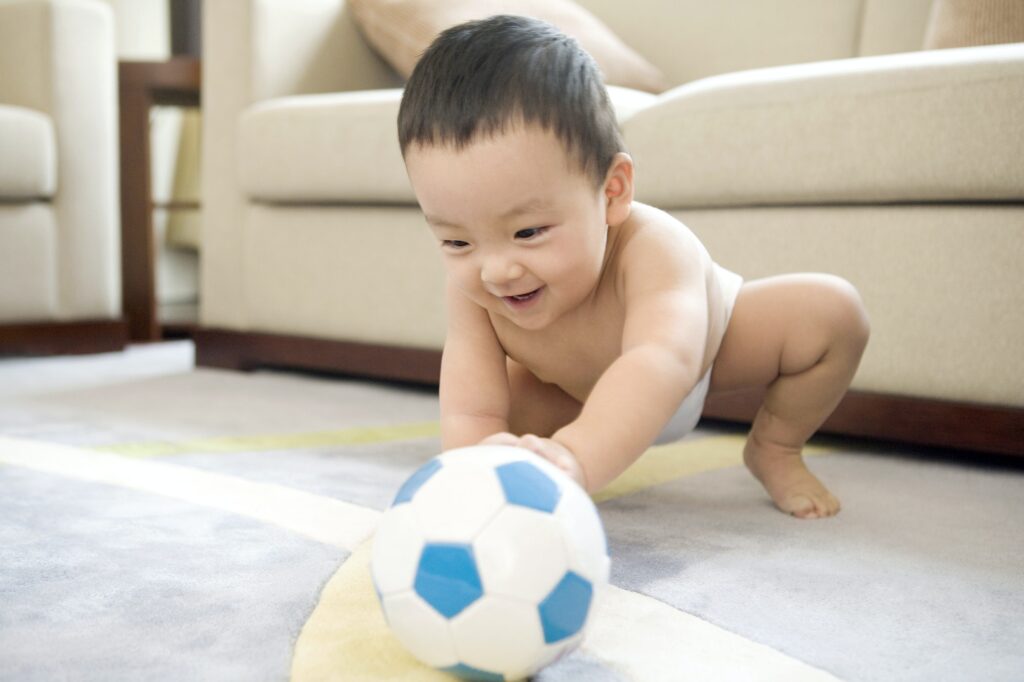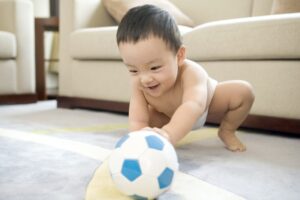
Cerebral Palsy: Infant Motor Skill Development
Cerebral Palsy: Infant Motor Skill Development A diagnosis of Cerebral Palsy can feel overwhelming for parents. By gaining an understanding of Cerebral Palsy infant symptoms

With so much information on the internet, it’s important to focus on the best tips for parents of babies with cerebral palsy for an optimal outcome.
Parents of babies and young toddlers with cerebral palsy or significant physical delays face many challenges.
This includes navigating an unfamiliar and unexpected path to help your child. It can be overwhelming to determine the best treatments when a baby is struggling to meet motor milestones.
Fortunately, you’ve found the best tips for parents of babies with cerebral palsy in 2023!
Research highlights a critical window of opportunity for “neuroplasticity” in babies and toddlers, especially before the age of two years.
Neuroplasticity is the brains’ ability to adapt, change, and grow new pathways. Neuroplasticity doesn’t just happen. Your baby needs the right stimulation at the right intensity.
According to Harvard University, more than 1 million new brain connections occur every second during the first few years of life (1).
That’s a good reason to make an intervention plan right away!
Here are your 5 best tips for parents of babies with cerebral palsy.

Children with Cerebral Palsy tend to reach 90% of their gross motor potential by age 5 with much of the progress occurring prior to the age of 2 years (2).
With inadequate or absent intervention, a young child could miss the opportunity for optimal motor learning.
Unfortunately, the “wait and see” approach is still common, especially for babies under 1 year. Only 50% of babies less than 12 months with or at risk for Cerebral Palsy receive therapy (3).
This needs to change!
Unfortunately, there can be negative effects when intervention happens too late. This includes unhealthy changes in the brain and body.
Children who do not have sufficient early intervention have a higher risk for hip dislocation, tight muscles, and deformities in their joints and bones (3).
By starting physical therapy right away, babies and toddlers have the best opportunity to develop skills when the brain is most open to positive change.
That’s good news!
Physical Therapy is important for developing gross motor skills and strength in children with Cerebral Palsy. This includes head control, rolling, sitting, standing, walking, carrying objects, climbing, and much more.
Development of gross motor control is also important as a precursor to fine motor control. For example, a child needs good core and shoulder strength to progress towards skillful use of their hands for fine motor play, coloring, and future school-related skills.
Physical Therapy begins with an evaluation and a treatment plan.
If you’re not sure if your child needs Physical Therapy, consider going through the evaluation process to receive recommendations.
Choose a Physical Therapist (PT) with experience serving children with Cerebral Palsy. It makes a difference when the Physical Therapist has knowledge about treatment based on current evidence.
It is never too early to start Physical Therapy!
This includes babies at risk for cerebral palsy who do not have an “official” diagnosis. In many US states, you can go to physical therapy without a prescription.
It’s possible to start physical therapy while waiting for appointments with specialists such as neurologists.
Children without disabilities develop motor skills by moving over and over again throughout the day.
Karen Adolph and colleagues from New York University found that typically developing toddlers take well over 2,000 steps per hour or 14,000 steps per day to master walking (4).
How do we help struggling babies to keep up to this pace?
Physical Therapy commonly occurs 1-4 times per week for babies and toddlers with Cerebral Palsy.
However, recent research challenges this frequency for children with significant delays in motor skills (3). Only a small fraction of high-quality motor learning time is possible with a few short physical therapy sessions per week.
More and more studies show the benefits of “Intensive Physical Therapy” for children with Cerebral Palsy.
Researchers from the CHA Bundang Medical Center found more improvements in children receiving intensive regimens of 22 visits per week for 1 month as compared to only 4 visits per week for 3 months (5).
A skilled pediatric Physical Therapist knows how to engage your baby or toddler for extended periods of time in everyday activities with optimal movement.
Talk with your Physical Therapist about “intensive” therapy with longer and more frequent sessions.
Intensive physical therapy could provide a more efficient way of developing skills with a skilled Physical Therapist.
Recent research shows that activity-based treatment or active movement interventions are favored strongly over passive treatment such as massage and stretching (3, 8).
While it’s tempting for an adult or therapist to move a child through motions, “adult-initiated” movements may not be the best approach to build brain pathways.
“Child-initiated movements” are critical to harness the power of neuroplasticity.

It’s important to find activities to encourage active movement.
Play should include activities that are meaningful and motivating for the baby and toddler.
Set up your home environment to encourage movement.
Toy selection is different for each child and it’s important to find toys that are highly motivating. Experiment with toys that make music, vibrate, light-up, or move.
Place favorite toys in the “just right place” for baby to reach, swipe, lean, roll, or look with little or no help.
Remember that your face and voice are often the most interesting to your baby! Get down at eye level within 8-12” of your baby while talking or singing gently for encouragement.
It may feel overwhelming to get a plan in motion to help your child with Cerebral Palsy or with delays in achieving gross motor skills.
Leverage your resources and ask for help from family, friends, church, community organizations, and schools.
People often want to help, but they don’t know how or what to do.
It’s ok to be direct! Ideas include help with meals, house cleaning, childcare, and fundraising efforts when insurance does not cover needed services.
When you accept assistance from others, this could free up your time and finances to focus on finding and participating in the best therapy possible for your child at the most critical time in life during those first 2 to 3 years.
Your baby needs you at your best!
One of the best tips for parents of babies with cerebral palsy and motor delays is to take care of you!
Parent support groups may be helpful in finding resources and encouragement from others who “walk in your shoes.”
This includes online supports such as Facebook groups and organizations like CHASA – the Childhood Hemiplegic and Stroke Association.

“I believe that the greatest gift you can give your family and the world is a healthy you.”
Joyce Meyer
Federal regulations require each state to provide “Early Intervention” services for children under the age of 3, regardless of income level under IDEA- the Individuals with Disabilities Education Act (6).
The purpose of Early Intervention is to enhance development and minimize developmental delay.
Early Intervention services can be very helpful in supporting parents in the home environment. Professional services might include a Developmental Specialist, Physical Therapist, Occupational Therapist, Speech Therapist, and other services based on your family and child’s needs.
In Early Intervention, parents learn strategies to help your child as their first and best teacher.
However, recent research indicates that traditional early intervention may not lead to the motor gains needed by a child with Cerebral Palsy (3,7).
Highly skilled and intensive Physical Therapy may be needed to treat difficult issues such as spasticity, tight muscles, joint deformities, and muscle tone problems. This type of intervention requires specialized training, beyond what many parents can learn within the short window of opportunity for neuroplasticity.
Talk to your Early Intervention providers right away if your child is not making significant gains in motor skills or if you feel overwhelmed.
Parents need to be parents, first and foremost.
Ask your Early Intervention providers for referrals to physical therapists or programs offering specialized intensive physical therapy services. A child can receive services from both state-run Early Intervention programs and specialized physical therapy providers at the same time.
See the link in the references for your state’s Early Intervention program.
Sometimes well-meaning professionals and adults provide advice to “wait and see” for babies struggling to meet motor milestones or with symptoms of cerebral palsy.
While this advice may be well intended, there is potential to miss an optimal window of opportunity for developing essential movement skills.
Delays in treatment could leave a young baby vulnerable to developing counterproductive movements that could last for a lifetime.
Remember these best tips to help bablies and children with cerebral palsy and motor delays.
Consider Thrive Sweet Physical Therapy and Wellness in Northeast Ohio. Dr. Sweet will consider traveling to any location in the State of Ohio. Call 440-525-2792 or check out www.thrivesweet.com for more information.
Check out the Thrive Sweet Baby and Toddler Program! Pediatric Physical Therapy

Cerebral Palsy: Infant Motor Skill Development A diagnosis of Cerebral Palsy can feel overwhelming for parents. By gaining an understanding of Cerebral Palsy infant symptoms

Facebook Linkedin Youtube Instagram HERE ARE THE 5 BEST TIPS FOR PARENTS OF BABIES WITH CEREBRAL PALSY IN 2023 With so much information on the
This blog is for general informational and entertainment purposes only and any use of this information is at the user’s own risk. This blog does not constitute the practice of medicine, professional health care services, the giving of medical advice, diagnosis, treatment, or any other medical service. While this content writer is a Physical Therapist, she is not your physical therapist, and no patient/client relationship is formed by reading this blog. Blog content on this website is not intended to be a substitute for professional medical advice, diagnosis, or treatment. Users should not delay in seeking medical advice for any concerns about medical conditions.
This website may contain “affiliate links” within website pages or blog posts. We assume no responsibility for errors or omissions caused by other websites that may be included our written materials. We have no control over the contents or functionality of those affiliate websites and so we accept no responsibility for any loss, damage, or otherwise that may arise from your use of them and therefore we do not guarantee the accuracy, completeness, or usefulness of any other website or their content. It is your responsibility to review the terms and conditions and privacy policies of those linked websites to confirm that you understand and agree with those policies.
Please note that by purchasing an item through an affiliate link, Thrive Sweet Physical Therapy & Wellness receives a small commission. While purchase through our website does not constitute warranty or produce guarantee, we share only familiar products and services we personally use. You understand that you are not obligated to purchase these items, and can purchase items from any source of your choosing. You understand that the services you are offered will not be affected if you choose to purchase similar items elsewhere.
(440) 525-2792 (call or text)